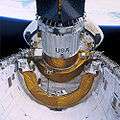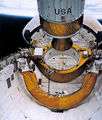Inertial Upper Stage
 Painting of Ulysses deploying from the Space Shuttle | |
| Manufacturer | Boeing United Technologies |
|---|---|
| Country of origin | United States |
| Used on | Space Shuttle Titan 34D Titan IV |
| General characteristics | |
| Height | 5.2 m (17 ft)[1] |
| Diameter | 2.8 m (9 ft 2 in) |
| Gross mass | 14,700 kg (32,400 lb) |
| Associated stages | |
| Derivatives | TOS |
| Launch history | |
| Status | Retired |
| Total launches | 24 |
| Successes (stage only) |
21 |
| Failed | 2 |
| Lower stage failed |
1 |
| First flight | 30 October 1982 |
| Last flight | 14 February 2004[2] |
| Stage 1 | |
| Length | 3.15 m (10.3 ft)[3] |
| Diameter | 2.34 m (7 ft 8 in)[3] |
| Gross mass | 10,400 kg (22,900 lb)[3] |
| Propellant mass | 9,700 kg (21,400 lb)[1] |
| Engines | Orbus-21 |
| Thrust | 190 kN (43,000 lbf)[1] |
| Specific impulse | 295.5 s[3] |
| Burn time | up to 150 seconds[1] |
| Fuel | Solid |
| Stage 2 | |
| Length | 1.98 m (6 ft 6 in)[3] |
| Diameter | 1.60 m (5 ft 3 in)[3] |
| Gross mass | 3,000 kg (6,600 lb) |
| Propellant mass | 2,700 kg (6,000 lb)[1] |
| Engines | Orbus-6 |
| Thrust | 80 kN (18,000 lbf)[1] |
| Specific impulse | 289.1 s[3] |
| Fuel | Solid |
The Inertial Upper Stage (IUS), originally designated the Interim Upper Stage, was a two-stage solid-fueled rocket upper stage developed by Boeing for the United States Air Force beginning in 1976[4] for raising payloads from low Earth orbit to higher orbits or interplanetary trajectories following launch aboard a Titan 34D or Titan IV rocket, or from the payload bay of the Space Shuttle.
Development
During the development of the Space Shuttle, NASA, with support from the Air Force, wanted an upper stage that could be used on the Shuttle to deliver payloads from low earth orbit to higher energy orbits such as GTO or to escape velocity for planetary probes. The candidates were the Centaur, propelled by liquid hydrogen and liquid oxygen, the Transtage, propelled by hypergolic storable propellants Aerozine-50 and N2O4, and the Interim Upper Stage, using solid propellant. The DOD reported that Transtage could support all defense needs, but could not meet NASA's scientific requirements, the IUS could support most defense needs and some science missions, while the Centaur could meet all needs of both the Air Force and NASA. Development began on both the Centaur and the IUS, and a second stage was added to the IUS design which could be used either as an apogee-kick motor for inserting payloads directly into geostationary orbit or to increase the payload mass brought to escape velocity.[5] Development of the Shuttle-Centaur was halted after the Challenger disaster, and the Interim Upper Stage became the Inertial Upper Stage.
When launched from the Space Shuttle, IUS could deliver up 2,270 kilograms (5,000 lb) directly to GEO or up to 4,940 kilograms (10,890 lb) to GTO.[3]
The first launch of the IUS was in 1982 on a Titan 34D rocket from the Cape Canaveral Air Force Station shortly before the STS-6 Space Shuttle mission.[6] Boeing was the primary contractor for the IUS[7] while Chemical Systems Division of United Technologies built the IUS solid rocket motors.[8]
Applications
.jpg)
On Titan launches, the Titan booster would launch the IUS, carrying the payload into low Earth orbit where it was separated from the Titan and ignited its first stage, which carried it into an elliptical "transfer" orbit to a higher altitude. On Shuttle launches, the orbiter's payload bay was opened, the IUS and its payload raised to a 50° angle, and released. After the Shuttle separated from the payload to a safe distance, the IUS first stage ignited and, as on a Titan booster mission, entered a "transfer orbit". Upon reaching apogee, the first stage and interstage structure were jettisoned. The second stage then fired to circularize the orbit, after which it released the satellite and, using its attitude control jets, began a retrograde maneuver to enter a lower orbit to avoid any possibility of collision with its payload.
In addition to the Communication and Reconnaissance missions described above, which placed the payload into stationary (24-hour) orbit, the IUS was also used to boost spacecraft towards planetary trajectories. For these missions, the second IUS stage was separated and ignited immediately after first stage burnout. Igniting the second stage at low altitude (and thus, high orbital speed) provided the extra velocity the spacecraft needed to escape from Earth orbit (see Oberth effect). IUS could not impart as much velocity to its payload as Centaur would have been able to: while Centaur could have launched Galileo directly on a two-year trip to Jupiter, the IUS required a six-year voyage with multiple gravity assists.[9]
The final flight of the IUS occurred in February 2004.[2]
Flights
| S/N[10] | Launch Date | Launch Vehicle | Payload | Remarks | Image |
|---|---|---|---|---|---|
| 2 | 1982-10-30 | Titan 34D | DSCS II F-16/III A-1 | Mission successful despite telemetry loss for most of the flight. | |
| 1 | 1983-04-04 | Space Shuttle Challenger (STS-6) |
TDRS-1 (TDRS-A) | The second stage tumbled due to a thruster motor problem, resulting in an incorrect
orbit. The Boeing staff that was monitoring the flight, was able to separate the tumbling IUS from the satellite so it could be maneuvered into its final orbit. |
 |
| 11 | 1985-01-24 | Space Shuttle Discovery (STS-51-C) |
USA-8 (Magnum) | Classified DoD payload | |
| 12 | 1985-10-03 | Space Shuttle Atlantis (STS-51-J) |
USA-11/12 (DSCS) | Classified DoD payload | |
| 3 | 1986-01-28 | Space Shuttle Challenger (STS-51-L) |
TDRS-B | Destroyed during launch[11] | |
| 7 | 1988-09-29 | Space Shuttle Discovery (STS-26) |
TDRS-3 (TDRS-C) |  | |
| 9 | 1989-03-13 | Space Shuttle Discovery (STS-29) |
TDRS-4 (TDRS-D) | ||
| 18 | 1989-05-04 | Space Shuttle Atlantis (STS-30) |
Magellan | Probe to Venus |  |
| 8 | 1989-06-14 | Titan IV (402) A | USA-39 (DSP) | ||
| 19 | 1989-10-18 | Space Shuttle Atlantis (STS-34) |
Galileo | Probe to Jupiter |  |
| 5 | 1989-11-23 | Space Shuttle Discovery (STS-33) |
USA-48 (Magnum) | Classified DoD payload | |
| 17 | 1990-10-06 | Space Shuttle Discovery (STS-41) |
Ulysses | Probe to the polar regions of the Sun | |
| 6 | 1990-11-13 | Titan IV (402) A | USA-65 (DSP) | ||
| 15 | 1991-08-02 | Space Shuttle Atlantis (STS-43) |
TDRS-5 (TDRS-E) |  | |
| 14 | 1991-11-24 | Space Shuttle Atlantis (STS-44) |
USA-75 (DSP) | ||
| 13 | 1993-01-13 | Space Shuttle Endeavour (STS-54) |
TDRS-6 (TDRS-F) |  | |
| 20 | 1994-12-22 | Titan IV (402) A | USA-107 (DSP) | ||
| 26 | 1995-07-13 | Space Shuttle Discovery (STS-70) |
TDRS-7 (TDRS-G) | ||
| 4 | 1997-02-23 | Titan IV (402) B | USA-130 (DSP) | ||
| 21 | 1999-04-09 | Titan IV (402) B | USA-142 (DSP) | IUS first and second stages failed to separate, payload placed into useless orbit | |
| 27 | 1999-07-23 | Space Shuttle Columbia (STS-93) |
Chandra X-ray Observatory |  | |
| 22 | 2000-05-08 | Titan IV (402) B | USA-149 (DSP) | ||
| 16 | 2001-08-06 | Titan IV (402) B | USA-159 (DSP) | ||
| 10 | 2004-02-14 | Titan IV (402) B | USA-176 (DSP) | ||
Gallery
 TDRS-C in Space Shuttle Discovery's payload bay
TDRS-C in Space Shuttle Discovery's payload bay Tilt table in deploy position
Tilt table in deploy position Release of TDRS-C
Release of TDRS-C Ulysses used a PAM-S and IUS combination
Ulysses used a PAM-S and IUS combination
References
- 1 2 3 4 5 6 "Inertial Upper Stage". Retrieved July 2014. Check date values in:
|access-date=(help) - 1 2 "Inertial Upper Stage". Boeing. Archived from the original on 21 July 2012. Retrieved 21 July 2012.
- 1 2 3 4 5 6 7 8 "Inertial Upper Stage". Retrieved 21 July 2012.
- ↑ "Boeing launches two satellites". The Bulletin. UPI. 1 November 1982. p. 3. Retrieved 23 February 2014.
Boeing won the contract to develop the IUS in 1976...
- ↑ Virginia Dawson; Mark Bowles. "Taming liquid hydrogen : the Centaur upper stage rocket" (PDF). nasa.gov. p. 172. Retrieved July 2014.
They argued that the IUS, which was designed by the Air Force, was a potentially better rocket. The first stage of the two-stage rocket was capable of launching medium-sized payloads at most. This limitation would be overcome by means of the addition of a second stage for larger payloads with destinations into deeper space. Specifically, the Air Force asked NASA to develop an additional stage that could be used for planetary missions such as a proposed probe to Jupiter called Galileo.
Check date values in:|access-date=(help) - ↑ http://www.globalsecurity.org/space/library/report/1994/cape/cape2-6.htm
- ↑ http://www.globalsecurity.org/space/systems/t4-config-2b.htm
- ↑ http://science.ksc.nasa.gov/shuttle/technology/sts-newsref/carriers.html
- ↑ Virginia Dawson; Mark Bowles. "Taming liquid hydrogen : the Centaur upper stage rocket" (PDF). nasa.gov. p. 211. Retrieved July 2014. Check date values in:
|access-date=(help) - ↑ Krebs, Gunter. "IUS". Gunter's Space Page. Retrieved 21 July 2012.
- ↑ "Tracking and Data Relay Satellite System (TDRSS)". NASA Space Communications. Retrieved 2009-06-25.
External links
- article Evolution of the Inertial Upper Stage page 38 Crosslink Winter 2003 Vol 4 Num 1 (published by The Aerospace Corporation)
- Inertial Upper Stage at Federation of American Scientists


